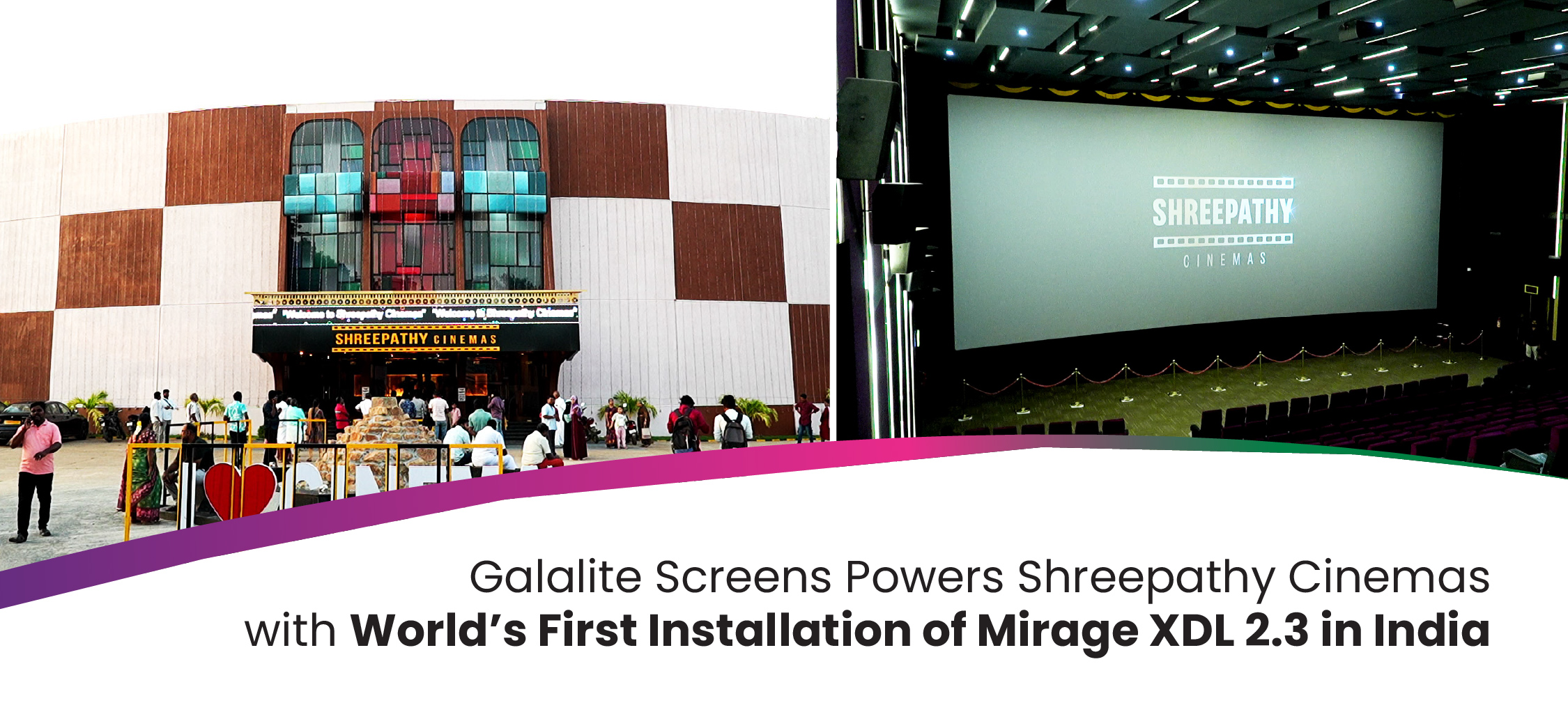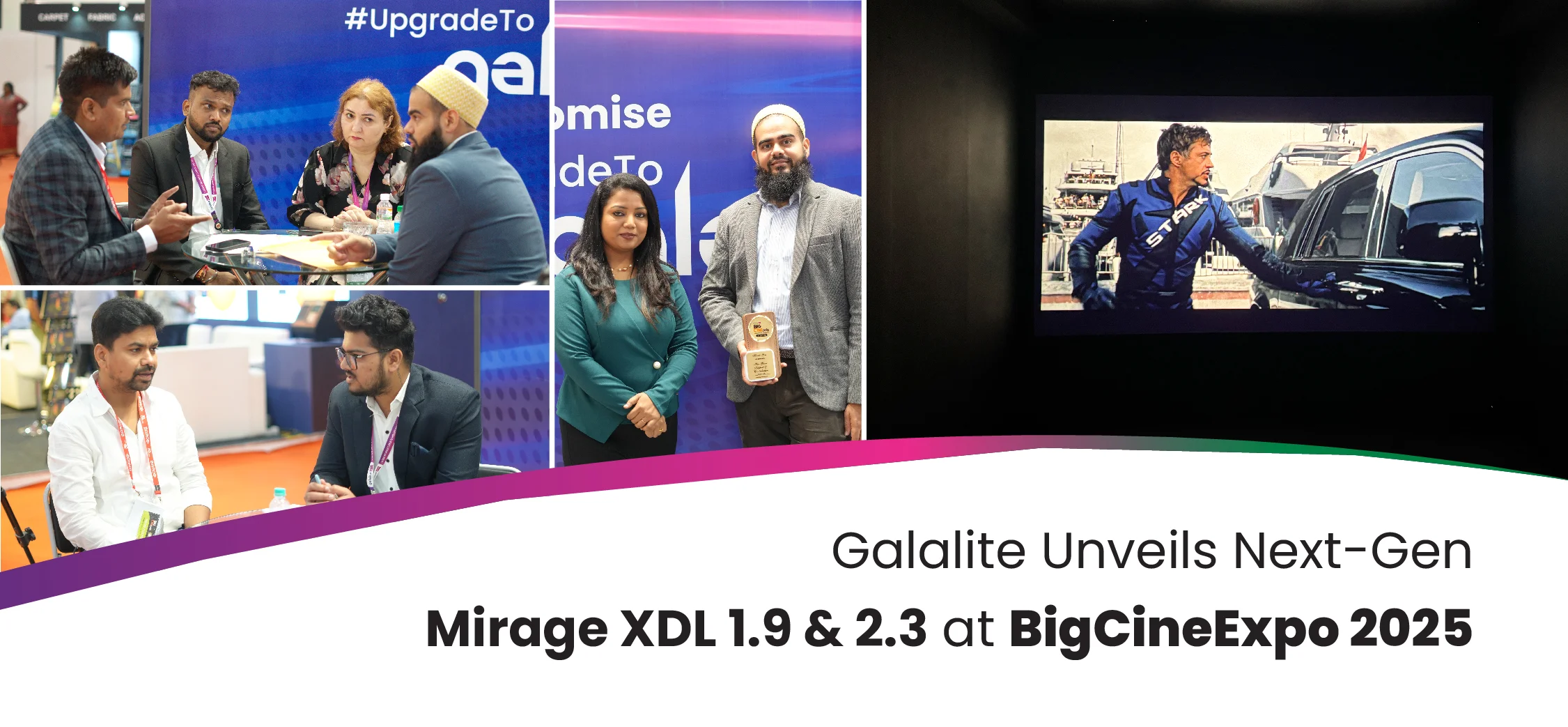
A ‘Prism 3D’ screen is a product designed and built to deliver minimally altered polarized light; it has been a core part of Galalite’s business activity since installing their state of the art coating plant in 2008. This high-gain screen would preserve the state of polarization sent through the synchronized projectors, and make up for the insertion losses of the projector mounted filters, and the corresponding filters in the glasses.
Let’s objectify the issue!
Silver screens have high-gain and very narrow viewing ‘cone factors’ that help preserve the polarized state of light projected upon them. Due to this, they perform poorly in most measurable quality yardstick valued in projection screen applications. Insertion loss, an inevitable aspect of implementing any 3D schedule, results in very low light levels coming off from the screen. If a venue is to be used for 2D projection as well, without filters and glasses, the Silver screens displays a distracting hot spot, inferior centre to edge uniformity and excessive color shift even if it is slightly off axis.
What causes this?
The Silver screens has been a faltering weakness in the event of preserving polarization. Legacy technology Silver screens tend to have similar metrics; the ‘extinction ratio’ is a critical metric for a Prism screen, which provides a contrast ratio between the maximum light passable through filter and glasses in an ‘open’ condition, divided by the lowest amount of light passed by the same filter regimen in a ‘closed’ condition.
Using this metrics, we can understand that a high performance Silver screens can hold two channels of information at the ratio of 350:1, using ‘quality linear polarizing filters’. Circular polarization ratios tend to yield a bit lower, due to the ‘quarter wave baseline component’.
A narrow viewing cone is a crumbling side effect of a high ratio of extinction. A quality matte fabric made with optimum center to edge performance will have a viewing cone of at least 85°, Galalite manufactures this and many other high performance matte elevated gains with a tailored off axis behavior, teamed with viewing cones well over 65°. These appear flat with polarized light. Having stated that, a screen with excellent ratio of extinction usually has a viewing cone of between 14 and 24°, and typically very high gain, 3.0 to 4.0 and distinct hot spot behavior under projection.
Most commercial cinema projection is designed at fairly long throws of ratio 3:1, 5:1 and higher in big houses. This helps disguise the flaws of the Silver screens, since long throw projection showcases light through an orthogonal distribution than a short throw system. Home cinema and post production screening rooms are often built with shorter throws. In setups like these, the typical Silver screens shows a pronounced hot spot and the lack of center to edge uniformity and also a colour shift mostly seen in many high gain screens. When 3D is projected on a screen, the depth effect masks the hotspot and shows off well till a well lit high key shot shows up and reveals the problems. In case a high definition 2D material is shown on such a screen, the planar surface of the screen, the unkind and inaccurate colorimetric tendencies, and the polarizing beam splitting treatment of white fields is revealed. In the world of commercial cinema, the proliferation of 3D content has been extensive, with many features competing for a limited, but expanding amount of 3D capable theatres. In home cinema, the market penetration of 3D content is not as extensive, and few viewers have purpose built venues for 2D and 3D. A single home cinema is available and usually there is one screen. Typical Silver screens are very far from the performance of reference quality for 2D and many rooms just cannot accommodate a two screen solution, and are too short in throw to work correctly with Silver screens. Parabolic screen surfaces are offered but they do not co-exist with proper masking systems and offer sub-par performance for both formats. The Silver screens is therefore problematic in home cinema.
The Basic Solution
So here’s Galalite’s solution; cut that problematic behavior in half, thanks to the relentlessly evolving R&D.
Reducing hot spotting and improving center to edge uniformity, however possible is a genuine consensus request. Lowering the gain of a Prism screen seems like an easy answer but then the crucial ratio of extinction will plummet disproportionately. Insufficient ratio of extinction results in ghosting, and often times a grain to the appearance of the screen. When the tipping point of functionality is reached, the screen may present an image which resembles the fog of analog static interference, which is not acceptable. The gain is lowered naturally, the viewing cone will widen and the screen will start behaving more like a normal screen, better centre to edge uniformity, less hot spotting. The upside of this possibility was too enticing for Galalite’s engineers to ignore. So they got to work to really explore how to lower the gain of a Prism screen without crashing the critical ratio of extinction. This is the premise and delivery of Galalite’s Prism3D’s fabric.
Galalite Prism 3D; the answer!
Galalite’s R&D team, the cinema screen masterminds, are continuously quantifying, re-formulating, refining and prototyping new ways of producing Silver Screen surfaces for Passive 3D. From the method and formulation of the substrate, to the formulation and application of the optical coating, every minute detail has been thought of and incorporated. This resulted in umpteen sample formulations, exploring the function and nature of the ratio of extinction and how it works on a microscopic scale. Theories and sub theories were tested and verified under this projection. The geniuses at Galalite didn’t leave anything to imagination while working checked and rechecked every minute detail to really understand how each change in formulation and each trend in the metrics affect all measurable and observable behaviors of the surface; which is why Galalite is re-defining what can be done with a polarization preserving screen. With significantly wide viewing cone of 25° from centre, Prism 3D screens provide a highly improved and evolved centre to edge uniformity* and yet furnishes a robust ratio of extinction, 140:1, enough to furnish ghost free images!
*when comparing to competitors and other screens available in the market.
Related articles



